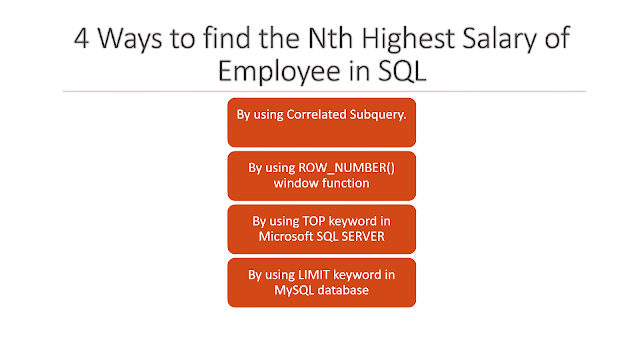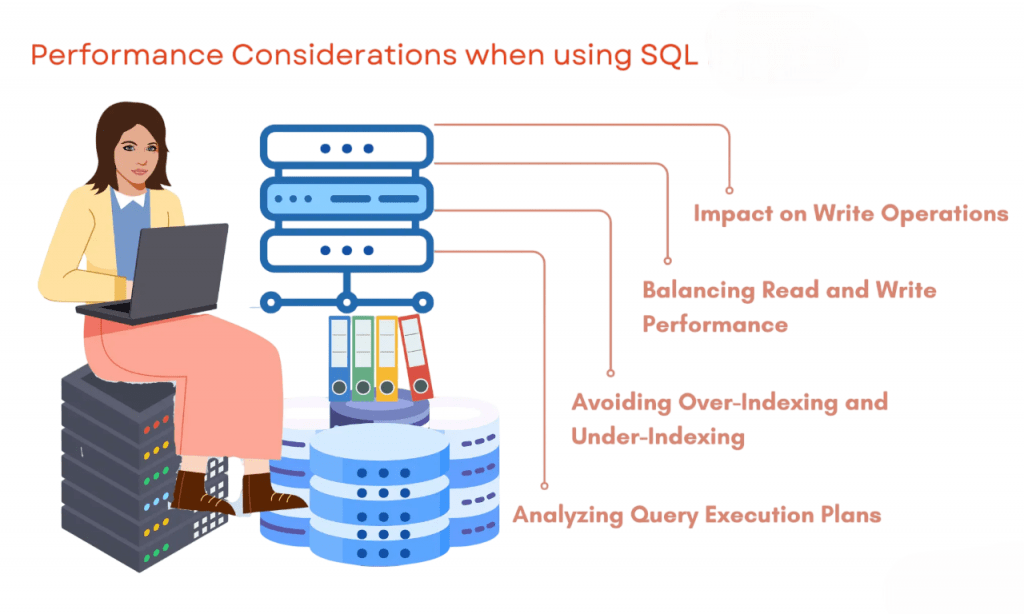
- Introduction
- Why You Might Need to Find the Second Highest Salary in SQL
- SQL Concepts Behind Ranking Salaries
- Methods to Find the Second Highest Salary in SQL
- Using LIMIT and OFFSET (MySQL/PostgreSQL)
- Using TOP with ORDER BY and NOT IN (SQL Server)
- Using ROW_NUMBER() Function
- Using RANK() and DENSE_RANK()
- Dealing with Duplicate Salaries
- Performance Considerations
- Common Mistakes to Avoid
- Conclusion
Introduction
In relational databases, analyzing employee or payroll data is a frequent requirement in both business reporting and technical interviews. A classic example is the need to find the second highest salary in a company. At first glance, this seems like a simple problem. But depending on your SQL dialect, solving it effectively might require insights you can gain from DataBase Training. On your SQL dialect, data structure, or presence of duplicate salary values, the query can become more complex than expected. Whether you’re preparing for an interview or building analytics queries, understanding how to accurately and efficiently retrieve the second highest salary demonstrates both your command over SQL and your awareness of database-specific syntax and features.
Why You Might Need to Find the Second Highest Salary
Business reporting is important for finding the next best-paid employee. Performance comparisons frequently use the Find the Second Highest Salary in SQL method. Talent analytics helps HR teams examine salary ranges, which allows them to evaluate how competitive their pay packages are. Promotion analysis is also done to identify the second top-performing employee who qualifies for a promotion. Hiring decisions benefit from this information, as companies can see salary differences between current workers and new hires an insight that stems from Understanding the data independence in DBMS. Additionally, security checks are important for spotting any salary issues that might indicate data leaks or unauthorized changes. To maintain data accuracy, organizations perform data quality checks to find gaps or unusual patterns in salary information. Finally, grasping these ideas is crucial since they often come up in interview preparation, especially during coding rounds for data analyst and backend positions.
Interested in Obtaining Your Data Science Certificate? View The Data Science Online Training Offered By ACTE Right Now!
SQL Concepts Behind Ranking Salaries
To solve the “second highest” problem:
- ORDER BY: Helps sort data ascending or descending.
- LIMIT or OFFSET: Can help fetch specific rows (MySQL, PostgreSQL).
- Ranking functions: ROW_NUMBER(), RANK(), and DENSE_RANK() assign position numbers to rows based on the sort order.
- Subqueries and aggregate functions: Can be used to filter based on conditions like MAX(salary) < (SELECT MAX(salary)).
Understanding these tools makes it easier to write correct and efficient queries across different SQL environments.
To Explore Data Science in Depth, Check Out Our Comprehensive Data Science Online Training To Gain Insights From Our Experts!
Methods to Find the Second Highest Salary
Here are the main strategies used:
- Subqueries: Compare the max salary against another max from a filtered dataset.
- LIMIT/OFFSET: Skip the first record and get the next.
- ORDER BY with TOP or FETCH NEXT: SQL Server and Oracle syntax.
- Window Functions: Use ranking to assign row numbers and filter accordingly.
- NOT IN / NOT EXISTS: Eliminate the highest salary and get the max of the remaining.
- CTEs (Common Table Expressions): Use readable subqueries with ranking.
- Join-based Solutions: Self-joins to compare employee salaries.
- Edge-Case Consideration: Handling duplicates, NULLs, or very large tables.

Each method varies depending on SQL dialect and table structure.
Using LIMIT and OFFSET (MySQL/PostgreSQL)
In SQL, you can find the second highest salary with a simple query that uses the LIMIT and OFFSET clauses. This works well in MySQL and PostgreSQL. By using the ORDER BY salary DESC command, salaries are arranged from highest to lowest. The DISTINCT keyword ensures only unique salary values are included. The query uses OFFSET 1 to skip the highest salary and LIMIT 1 to return the next row. THis way, it precisely retrieves the second highest salary from the employees table a technique often covered in DataBase Training. This method offers a clear and efficient way to get the desired salary information without much computational complexity. This method is effective because it is simple and does not need complicated subqueries or joins. It provides a clear and efficient way to find the second highest salary with minimal effort. This is especially helpful in large tables where efficiency is important, as it quickly reduces the results without heavy computations. This approach offers a reliable way to get important salary information without straining the database or causing slow response times. Overall, it is a straightforward method that combines ease of use, speed, and accuracy when accessing the second highest salary data.
Using TOP with ORDER BY and NOT IN (SQL Server)
In SQL Server, getting the second-highest salary takes a careful approach using the TOP clause and a subquery. First, developers find the maximum salary with a subquery. They can then use the TOP 1 command to pull the next highest value from the employees table. The query sorts salaries in descending order and applies filters to ensure the correct selection of the second-highest salary, a common task explained in how to become an sql developer guides. To deal with potential salary duplicates, using the DISTINCT keyword adds extra data precision, which helps in making better salary comparisons and reporting. Finding the second-highest salary in SQL Server involves filtering, sorting, and using keywords effectively. It requires writing queries that are clear and specific. This process helps ensure that the data you report reflects actual figures and prevents mistakes or misunderstandings from incorrect assumptions. This technique is vital for working efficiently with large databases where accuracy is important.
Gain Your Master’s Certification in Data Science Training by Enrolling in Our Data Science Master Program Training Course Now!
Using ROW_NUMBER() Function
ROW_NUMBER() gives each row a unique number based on ordering:
- CopyEdit
- SELECT salary
- FROM (
- SELECT salary, ROW_NUMBER() OVER (ORDER BY salary DESC) AS rn
- FROM employees
- ) AS ranked
- WHERE rn = 2;
- Guaranteed to return only one row even if salaries are duplicated.
- Best when you care about the exact “second row” based on sorted salaries a scenario where understanding Composite key in SQL explained can also be helpful.
- CopyEdit
- SELECT salary
- FROM (
- SELECT salary, DENSE_RANK() OVER (ORDER BY salary DESC) AS rnk
- FROM employees
- ) AS ranked
- WHERE rnk = 2;
- RANK() leaves gaps in rankings if duplicates exist.
- DENSE_RANK() avoids gaps, so the second unique salary always gets rank 2.
This is a more accurate approach when the second highest distinct salary is needed.
Are You Preparing for Data Science Jobs? Check Out ACTE’s Data Science Interview Questions and Answers to Boost Your Preparation!
Using RANK() and DENSE_RANK()
These functions handle duplicates more gracefully:
- sql
- CopyEdit
- SELECT salary
- FROM (
- SELECT salary, DENSE_RANK() OVER (ORDER BY salary DESC) AS rnk
- FROM employees
- ) AS ranked
- WHERE rnk = 2;
- RANK() leaves gaps in rankings if duplicates exist.
- DENSE_RANK() avoids gaps, so the second unique salary always gets rank 2.
This is a more accurate approach when the second highest distinct salary is needed.
Dealing with Duplicate Salaries
When dealing with real-world datasets that may have duplicated salaries, it’s essential to use the right SQL ranking techniques to get reliable results. First, professionals should apply the DISTINCT keyword before ranking or limiting data. This step helps remove duplicate entries. Care is needed when using ROW_NUMBER() because it might lead to surprising results if there isn’t perfect row uniqueness. For cases with tied values, DENSE_RANK() is a better choice, as it treats tied entries as a single rank. It’s also important to make a clear decision at the start about whether the aim is to find the second highest value or the second row in a list. For example, this distinction often relates to concepts tagged as Top Buzzword in Database Management , if the highest salaries are 90000 and the next is 85000, DENSE_RANK() would consistently show 85000 as the second highest salary. This makes DENSE_RANK() a more predictable and accurate ranking method than other options.
Performance Considerations
When working with large datasets:
- Use indexes on the salary column: For better sorting performance.
- Avoid nested subqueries: In SELECT or WHERE if performance is critical.
- Limit the result set: If you only need the second highest salary, to reduce scan time.
- Avoid repeated subqueries: That fetch the MAX(salary) more than once.
- Tip: Create a covering index on salary if it’s frequently queried in this pattern.

Common Mistakes to Avoid
- Forgetting about duplicates: Always clarify if you’re dealing with unique or repeated values.
- Using ROW_NUMBER() carelessly: It ignores duplicates and assigns sequential numbers.
- Querying without ORDER BY: Sorting is mandatory for identifying ranking correctly.
- Not testing on empty or small datasets: Some queries fail when there’s only one row or NULL values.
- Assuming the same logic works in all RDBMS: MySQL, SQL Server, and Oracle have different functions.
- Ignoring NULLs: If salary is nullable, it may impact MAX() or ORDER BY queries.
Conclusion
Find the second highest salary in SQL is a deceptively simple problem with many layers. The method you choose depends on: When choosing the second unique value or row, several important factors must be considered. The SQL dialect you are using, like MySQL, PostgreSQL, SQL Server, or Oracle, greatly impacts your method. It’s also crucial to decide if duplicate values matter for your query and to grasp the specific business logic behind your needs. You need to balance performance and readability. For a deeper understanding, you can explore DataBase Training that covers essential concepts and practical approaches. By carefully assessing these factors, you can create a focused SQL query that accurately retrieves the desired result efficiently. The safest and most flexible method is to use window functions like DENSE_RANK(), as they provide clarity and handle duplicates better. However, for interview scenarios or one-off reports, simpler methods like LIMIT or subqueries can suffice. By mastering these various strategies, you not only improve your technical skills but also gain versatility in working with different database systems and business cases.

